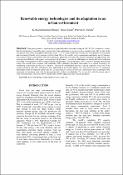Options
Renewable energy technologies and its adaptation in an urban environment
Date Issued
2014-02
Date Available
2014-11-07T10:07:17Z
Abstract
This general article is based on the inaugural talk delivered at the opening of OMTAT 2013 conference. It notes that the integration of renewable energy sources into living and transport sectors presents a daunting task, still. In spite of the fact that the earth and its atmosphere continually receive 1.7 × 1017 watts of radiation from the sun, in the portfolio of sustainable and environment friendly energy options, which is about 16% of the world’s energy consumption and mostly met by biomass, only a paltry 0.04% is accredited to solar. First and second generation solar cells offer mature technologies for applications. The most important difficulty with regards to integration with structures is not only the additional cost, but also the lack of sufficient knowledge in managing the available energy smartly and efficiently. The incorporation of PV as a part of building fabric greatly reduces the overall costs compared with retrofitting. BIPV (Building Integrated photovoltaic) is a critical technology for establishing aesthetically pleasing solar structures. Infusing PV and building elements is greatly simplified with some of the second generation thin film technologies now manufactured as flexible panels. The same holds true for 3rd generation technologies under development such as, and dye- and quantum dot- sensitized solar cells . Additionally, these technologies offer transparent or translucent solar cells for incorporation into windows and skylights. This review deals with the present state of solar cell technologies suitable for BIPV and the status of BIPV applications and its future prospects.
Other Sponsorship
SFI-Airtricity Stokes professorship grant
European Commission
Type of Material
Journal Article
Publisher
AIP Publishing
Journal
American Institute of Physics Proceedings
Volume
1576
Issue
3
Start Page
3
End Page
18
Copyright (Published Version)
2014 AIP Publishing LLC
Language
English
Status of Item
Peer reviewed
Conference Details
Optoelectronic Materials and Thin Films: OMTAT 2013. Kochi, Kerala, India, 3–5 January 2013
This item is made available under a Creative Commons License
File(s)
Loading...
Name
Renewable_energy_technologies_and_its_adaptation_in_an_urban_environment.pdf
Size
8.59 MB
Format
Adobe PDF
Checksum (MD5)
92bc44903595292ee4f0c032fad0f357
Owning collection